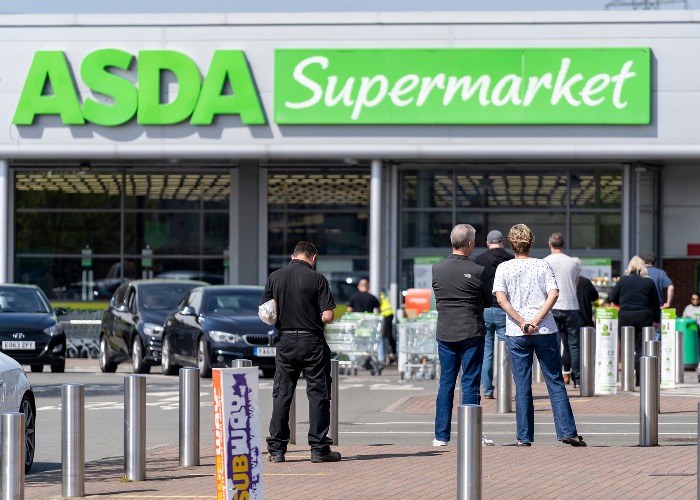Asda announces £15m giveaway and cuts hundreds of prices

Asda is cutting prices on selected items by 11% on average, while also giving customers the chance to win up to £100 through the Rewards app.
Asda has rolled out a raft of price cuts and launched a £15 million giveaway to customers who use its Rewards loyalty app.
To qualify for the giveaway, shoppers will need to spend at least £5 in-store or online and scan the app at the till.
This will then give them the opportunity to play a 'spin the wheel' game within the app, with prizes worth anywhere between 50p and £100 up for grabs.
The promotion will run throughout September.
Asda to cut prices on selected items
Asda has is also cutting the cost of 425 branded and own-label products, a move which is costing the supermarket around £23 million.
On average prices are being trimmed by 11%, with the products including the likes of nappies, bread, cheese, cereals, pasta, sausages and chicken.
Examples of price cuts included are detailed in the table below:
|
Product |
Old price |
New price |
|
Asda Succulent Chicken Leg Quarters |
£3.35 |
£2.60 |
|
Asda 8 Pork Sausages |
£2.30 |
£2.15 |
|
Asda 30 Fish Fingers |
£4.50 |
£3.70 |
|
Heinz Chopped Tomatoes 4x400g |
£4.75 |
£3.50 |
|
Asda Penne 3kg |
£4 |
£3.75 |
|
Hellman’s Real Squeezy Mayonnaise 235g |
£2 |
£1.85 |
|
Asda Mature Cheddar Cheese (400g) |
£3.20 |
£3 |
|
Asda Little Angel Comfort & Protect Nappies (various sizes) |
£3.25 |
£2.99 |
It’s not the only money saving move launched by Asda this week either.
The supermarket has also introduced a ‘back to school’ bonus on its app.
The app allows you to take advantage of its Rewards loyalty scheme, where you can build up a ‘cashpot’ ‒ effectively cashback ‒ by making qualifying purchases.
You can earn 10% back on school uniform clothing, football and accessories when you spend before 10 September, while you get a £2 boost if you spend £10 on other back-to-school essentials, like stationary, before 3 September.
Supermarkets are well aware of the financial pressures we all face at the moment, and so have been fiercely competing to win over more and more of us through new price promotions.
Falling food price inflation
It’s no secret that food price inflation has been a significant concern for most of us over the last year.
The rate at which our food bills have grown has been little short of staggering, with food price inflation at points nearing 20%.
There is some positivity to be taken from the fact that this inflation has peaked and is steadily falling.
The latest data from the British Retail Consortium shows that food price inflation dropped from 13.4% in July to 11.5% in August.
That’s the fourth straight drop in food price inflation, and means it is at its lowest level since September 2022.
It’s obviously welcome that food price inflation is slowing.
There is simply no way that any of us can cope with food prices rising at 20% for any prolonged period.
But the reality is that even with food price inflation dropping, the costs that we pay are still on the rise, just at a slower rate.
That can only put household budgets under ever greater pressure.
We don’t trust supermarkets
The situation with food prices has severely dented the level of trust we have in supermarkets to treat us fairly.
A study by Which? found that supermarket trust is at its lowest level since the horsemeat scandal back in 2013, and represents a big turnaround from the high level of trust seen during the pandemic.
Essentially shoppers are seeing the way that prices are being hiked, and for all of the talk from supermarkets about wanting to protect their customers where possible, shoppers aren’t convinced.
How do we deal with higher food prices?
The Which? study also quizzed shoppers on the changes they have made to their own food buying habits in response to the higher costs they are facing at the supermarket.
Here is how these different approaches are being utilised by shoppers:
|
Shopping change |
Percentage of shoppers making the change |
|
Bought cheaper products |
54% |
|
Bought more budget-range items |
48% |
|
Bought more items on promotion |
38% |
|
Shopped around in different places |
33% |
|
Gone without some foods |
24% |
|
Skipped meals |
15% |
|
Prioritised meals for other family members |
8% |
|
Used a food bank |
4% |
Clearly some of these measures are more extreme than others.
It’s one thing to focus more on cheaper items, or those that are on sale.
That’s a straightforward way to make some savings, and reduce the stress of the weekly big shop.
Similarly, moving to shopping in a different store is a move worth trying, and is something plenty of us are already doing.
It’s driven notable changes in market share among the nation’s supermarkets, with Lidl and Aldi the big beneficiaries.
However, there are some much bigger changes being made.
Skipping meals or prioritising them for others are only going to be adopted if you’re truly desperate, and that such sizeable numbers of people are doing this is a powerful indication of just how serious this situation has become.
So while falling food price inflation is welcome, it has much further to go before any of us really feel any difference to our bank balances.
Comments
Be the first to comment
Do you want to comment on this article? You need to be signed in for this feature
